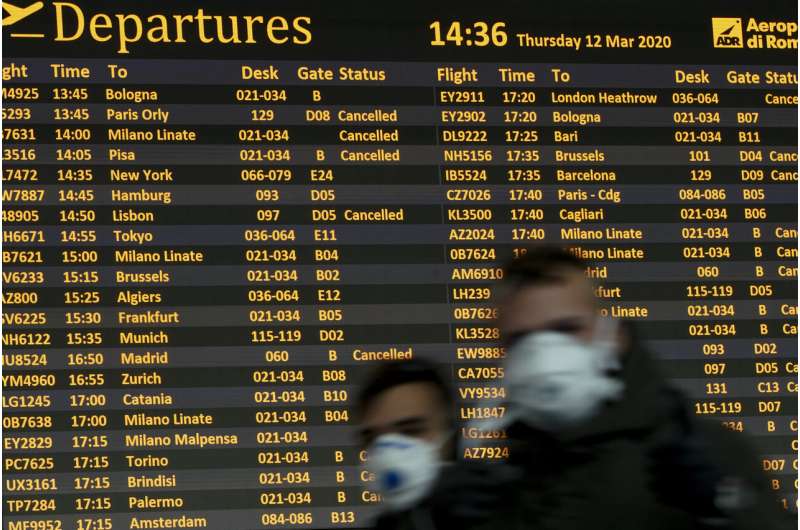People walk by a departures monitor at the Rome Leonardo da Vinci International Airport, Thursday, March 12, 2020. Airlines and travelers are still sorting out the new travel ban that President Donald Trump announced late Wednesday, barring most foreign visitors from continental Europe for 30 days. (AP Photo/Andrew Medichini, File)
Europe's aviation safety agency called on airlines and airports Tuesday to participate in a program to help evaluate new coronavirus guidelines in real-life situations.
The European Union Aviation Safety Agency published the guidelines last week in conjunction with the European Center for Disease Prevention and Control with the goal of allowing air travel to resume under safe conditions, both operationally and from a public health point of view.
The aviation agency said the evaluation program will focus on airlines that are fully applying the guidelines and flying to airports that are as well to get the best picture of how the recommendations are working and where improvement is needed.
"The airports and airlines participating in this program will be pioneers at the forefront of the return to normal operations after this unprecedented crisis for commercial aviation," EASA Executive Director Patrick Ky said. "The feedback they provide to us will be instrumental in ensuring that we genuinely achieve the health safety aims of these guidelines and will help the entire sector to resume operations in a way that makes passengers and staff feel safe and secure."
The guidance breaks down a passenger's travel journey into six segments: before getting to the airport; while inside the departure terminal; boarding; on a flight; en route transit; and arrival at the final destination. A separate section focuses on flight crew safety.
The safety protocols cover social distancing measures, hand hygiene and mask recommendations. They also rely on passengers taking personal responsibility, such as postponing travel if they learn they have been in contact with someone who has COVID-19.
"What is unique in the operational guidelines is the fact that they are validated both by aviation authorities as well as by health authorities," said Henrik Hololei, the European Union's director-general for mobility and transport. "Only if they work together, resumption of traffic will become possible."
The EU aviation safety agency said it built in flexibility on how to approach implementing the guidelines and hopes to learn from the real-life experience of airports and airlines.
Participating airlines and airports will need to sign a pledge to abide by the guidelines, coordinate with national authorities and to design practical solutions when they encounter problems meeting the recommended procedures.
Issues that come up will be reported to EASA and the European Center for Disease Prevention and Control together with weekly data and suggestions for improvement.
© 2020 The Associated Press. All rights reserved. This material may not be published, broadcast, rewritten or redistributed without permission.
























